Yamaha R1 and R1M 2020 test: hell of a blow … and salty extra cost !
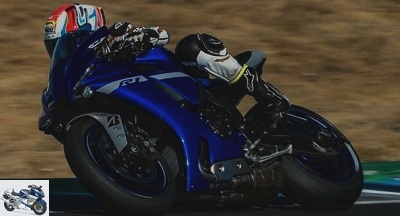
Yamaha is taking advantage of the changeover to the Euro5 standard to perfect its Superbike: the "short" R1 benefits from multiple improvements which should justify a tiny price increase. The R1M is also evolving … enough to justify the surge in its price? MNC tested the two sports bikes in Jerez (Spain). Verdict.
R1 2020 test page 3: Technical point
Engine
Despite its switch to Euro5, the CP4 engine (for "CrossPlane 4-cylinders") has the same maximum power of 200 horsepower and a torque similar to the previous version launched in 2015, certified Euro4. To do this, the 998 cc water mill had to undergo a series of upgrades.
High speed performance, which is essential for this type of motorcycle, has been maintained in particular thanks to the adoption of new rocker arms with pawls and new cam profiles, and to a redefinition of the opening and closing times of the valves..
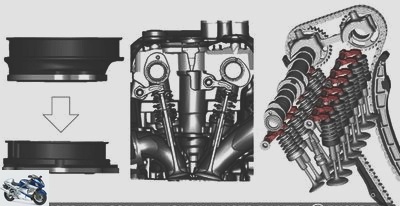
Besides the distribution, "one of the most important modifications of this model lies in the new conception of the admission", continue the Japanese engine manufacturers. The valves are brought closer to the chambers "in order to reduce the intake volume" by -12% exactly … and to improve combustion.
At the same time, new Bosch injectors are positioned above the 45 mm injection bodies, and no longer below. The fuel therefore arrives more directly in the combustion chambers, at a wider spray angle (21.5 ° for the curious).
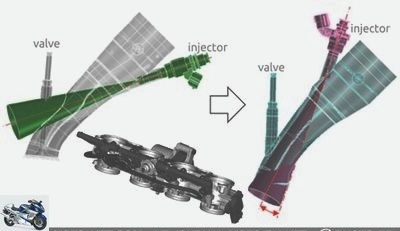
On the exhaust side, the cooling of the engine block at the (four) outputs is improved thanks to a new arrangement of the cylinder head coolant duct. The rest of the system is redesigned, including four catalysts (one pair in front of the exhaust chamber, a second behind). The titanium silencer and the thermal protections of the engine aim to limit the sound volume, without too much suffocating the engine.
The modification of the crankshaft lubrication circuit – with larger bearings -, the oil pump with a 10% more compact rotor, the resized oil ducts and the nozzles used to cool the pistons make it possible to limit power losses at high rpm.
Finally, the reliability of the machine is also improving on two specific points: the pinion of the second report is widened and the chain has stronger links..
Cycle part
If the Kayaba fork of 43 mm in diameter is renewed, its components have been modified to improve the feeling on the handlebars: "the new damping valves are arranged in stack, and this characteristic, associated with a lower calibration of the spring and a revised fork oil level, gives the driver more precise information on the running surface ".
The rear shock settings are tuned to those of the "new" fork. The steering damper is also slightly reconfigured. The rest of the chassis, tested and approved by Lowes and Van der Mark in World Superbike, is kept as is. "And we are delighted", assures boss Andrea Dosoli.
The two 320mm front brake discs are still clamped by "house", 4-piston monobloc calipers. For 2020, "pads with a new friction material increase the braking power", announce the Japanese, aware that their R1 2015 was not the best in the category on this point…
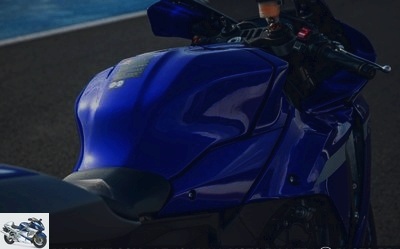
In terms of look, MNC must admit having always had a weakness for the R1 2015, for its front lines modeled on that of the M1 Grand Prix and for its rear part evoking the tail of a stealth aircraft. The 2020 model is evolving smoothly … or rigorously !
The face of the R1 thickens, but only takes muscle, zero fat. The side flanks now go up on the frame and join the tank – unchanged – of fuel, which should insulate a little better – a little longer – the thighs of the pilot from the heat of the boiler of 200 degrees horses.
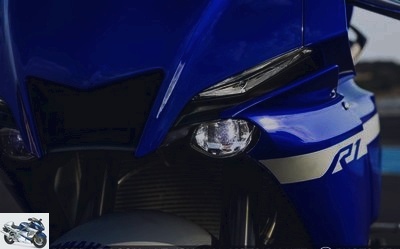
In addition to "a sleeker style and an even more upscale finish" claimed by Yamaha, this new trim improves the aerodynamics of the machine "by more than 5%, which translates into greater performance at high speed. . and by greater comfort on board.
The new R1 also takes the opportunity to integrate new LED headlights and redesigned LED position lights, which frame a more "MotoGPesque" air intake fitted with a new air duct now made of aluminum in order to gain rigidity. The lower part of the fairing that covers the exhaust system changes to titanium.
Finally, the latest Bridgestone Battlax RS11 tires allow exceptional traction and precise sensations, which allows the rider to push his limits even further..
Electronic
If the throttle opening was already electronic on the previous R1 (YCC-T system), the grip still used good old cables. For 2020, the Yam adopts an entirely "wireless" control "for a better feeling of acceleration and a reduced weight", legitimately the engineers.
Called APSG (throttle grip with position sensor), the device mimics the behavior of a conventional accelerator as closely as possible: "the rotation of the grip and the acceleration remain natural and progressive for better control and greater interaction pilot / machine ".

The YZF-R1 retains its technological paraphernalia, mainly its 6-axis inertial unit (IMU) which continuously assesses the movements of the motorcycle in three dimensions (forward, to the sides, and up and down), and also takes into account pitch, roll and yaw.
"For 2020, our top-of-the-range supersport (Superbike, Editor’s note!) Benefits from two new technologies which further increase its exceptional potential on the track", ignited the Japanese, which brought the number of driving assistance for their R1 to 7….
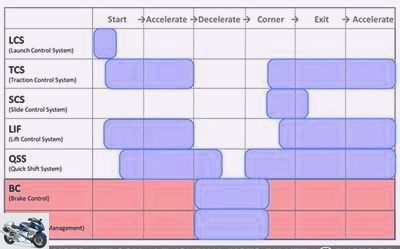
A new engine brake management (EBM) system offers the pilot the possibility of choosing among three levels of braking force: level 1 for a standard engine brake – as before, what! -, level 2 to moderate it a little, 3 to limit it further.
To intervene on the engine brake, the ECU takes into account the gear engaged, the engine speed, the position of the throttle grip and the position of the throttle valve. The control unit then acts on the opening of the throttle valves, the ignition timing and the injection to relieve the rear wheel..
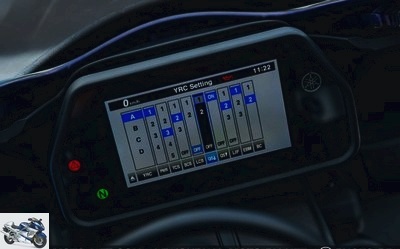
Second electronic novelty on the R1 2020: the brake control system (BC) allows the rider to juggle two ABS modes. BC1 mode offers constant ABS (that of the 2015-2019 R1), while BC2 mode adjusts the ABS according to the lean angle and the grip of the machine.
Finally, the starting assistance-on-the-wheel-hats (LCS) is modified: the LCS1 mode is activated a little higher in the revs (9000 rpm instead of 8000) and puts more gas (41 degrees against 38) to ensure the holeshot to the trackers.
R1M version
The luxury version of the R1 wears a carbon coat a little longer than on the previous (top) model since its tail is made up of precious fibers, such as the front fender, the face and the fairing sides..
At the request of previous customers, future models of R1M have a numbered plate intended to emphasize their exclusive character. The 2020 R1M also benefits – and above all ?! – a complete update of their Ohlins electronic suspensions…
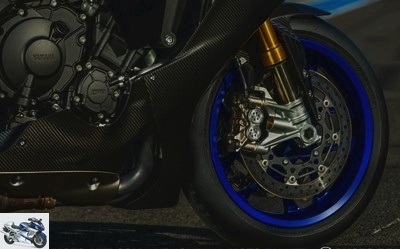
At the front, the NPX-EC fork has small pressurized gas cartridges (Nitrogen at 6 bars) which must reduce the cavitation of the fork oil caused by the depression produced during the rebound (always adjustable on the right tube, left compression).
According to Japanese officials, the new Swedish part offers multiple advantages: "more precise feeling of the front tire, better grip, greater control, increased confidence (and better lap times!)", They guarantee on account … which climbs 2000 (two thousand!) euros compared to last year’s R1M.
At the rear, the shock absorber benefits from latest generation valves, hydraulic and electronic adjustments redefined … in accordance with the new pressurized fork. The R1M obviously incorporates all the engine, electronic and aerodynamic modifications of the R1 "quite short and 6700 euros cheaper"…
Related articles
-
2017 Yamaha YZF-R6 test: no, the Supersport is not dead Yamaha is the only major motorcycle manufacturer to keep its 600 cc sports car in its catalog in…
-
Yamaha R1 and R1M 2020 test: hell of a blow … and salty extra cost ! Yamaha is taking advantage of the change to the Euro5 standard to perfect its…
-
2017 Suzuki V-Strom 1000 XT test: a super cost ! The Suzuki V-Strom 1000 , relaunched in 2013 after a career suspension in 2008 due to Euro 3 standards,…
-
Honda CBR1000RR / SP 2017 test: neither gross nor submitted ! Forget the old CBR1000RR lacking in performance and technology: Honda celebrates 25 years…
-
Sporty – First test MV Agusta F3 800: maxi Supersport – Technical update MV Agusta F3 800 EAS
MV Agusta F3 800 first test: maxi Supersport Developed at the same time as the 3-cylinder MV Agusta 675, the 800 cc version of the Tre Pistoni was…
-
Yamaha R1 and R1M 2020 test: hell of a blow … and salty extra cost ! Yamaha is taking advantage of the change to the Euro5 standard to perfect its…
-
Yamaha R1 and R1M 2020 test: hell of a blow … and salty extra cost ! Yamaha is taking advantage of the change to the Euro5 standard to perfect its…
-
Roadster – Yamaha MT-09 SP test: the one we SPEED! – MT-09 SP test page 3: Technical point
Yamaha MT-09 SP test: the one we Sought ! The Yamaha MT-09, one of the stars of the French motorcycle market, never ceases to enchant bikers eager for…
-
Yamaha R1 and R1M 2015 test: with or without M, we like ! Yamaha’s brand new sports bike is currently landing in French dealerships. But it was on the…
-
F900R test: the completely revised BMW roadster … with a dejà vu R BMW has just presented two major 2020 novelties to the international press: the…